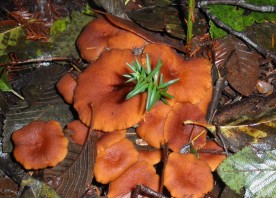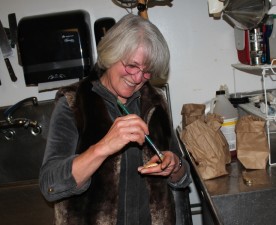Culinary
Wild mushrooms possess an amazing range of flavors and aromas! Beautiful packages of umami, they can be rich and meaty, subtle and delicate, and redolent of almonds and spice.
Learn how to properly clean, preserve and prepare your foraged finds to make the most of those flavors. Opportunities to learn range from tailgate tastings to sit-down dinners to demonstration-style cooking programs. Long distance forays typically include tastings of new and unusual mushrooms. Not sure what best showcases a particular mushroom? We welcome you to delve into our recipe archives for the answer. Visit our Culinary Forum
Generally speaking, the best mushrooms are fresh mushrooms. Refrigerate as soon as you get home, and don’t wash until you’re ready to prepare or process them. Store mushrooms in the fridge in paper or waxed paper bags, never plastic, as they need to breathe. Plastic bags will yield mush rather than mushrooms.
Wash or Brush?
One school of thought is that one must never get mushrooms wet, as this will dilute their flavor. Advocates instead carefully trim and brush their fungi clean. This can be achieved with a pristine bolete, but you’ll be crunching on grit if you try it with a mud puppy chanterelle!
Another perspective is that fungi absorb a negligible amount of water from washing, and that subsequent cooking will drive off the moisture along with that already present in the mushroom (they’re 90% water). Harold McGee, author of On Food and Cooking, a wonderful exploration of food chemistry and taste, did an experiment. He weighed 252 grams of fresh mushrooms, submerged them in water for 5 minutes, then removed them, blotted dry and weighed again. They then weighed 258 grams, 23 mushrooms having absorbed less than half a tablespoon among them. So he now rinses for 5 or 10 seconds with no compunctions. You can make up your own mind.
Preserving Your Bounty — May you be fortunate enough to find sufficient mushrooms for dinner and then some! Preserving the balance for future enjoyment is rewarding, and the method chosen will vary with different mushrooms and your personal preferences. But don't be greedy; be sure to leave a few behind to sporulate and make more...
Drying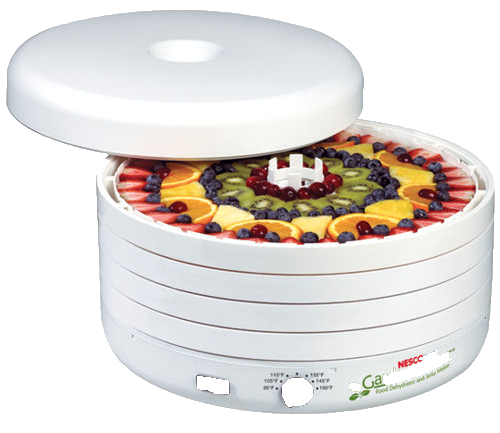
Advantages:
Doesn’t require freezer space
Some mushrooms are improved with dehydration (mature boletes, pine spikes)
Disadvantages:
Detrimental to quality and texture of some mushrooms (oysters, chanterelles, amanitas)
Method: Slice cleaned mushrooms approximately ¼” thick. Dry in dehydrator at lower temperature (100°-115°F) until potato chip crisp. Cool before packaging for storage. Alternate drying methods include utilizing screens in the sun or over heating vents inside. A little candy cap aromatherapy, anyone?
Some like to store in glass containers on the shelf, others prefer storing dried mushrooms in the freezer to discourage bugs that may have survived dehydration. Still others pack in Mason jars and vacuum seal with Foodsaver attachment, effectively suffocating the little buggers. This way jars can be stored on the shelf but insect activity is minimized or eliminated. Dried mushrooms can also be powdered in a coffee or spice grinder for later use. Many favor separating bolete tubes from flesh, then drying and powdering the tubes.
Good for: Mature boletes, craterellus, suillus spp., candy caps, pine spikes (yes!), winter chanterelles, Russula spp., Marasmius oreades, morels
Not so good for: Chanterelles, oysters, lobster mushrooms, amanitas
Freezing
Advantages: Quality close to fresh when properly done
Disadvantages: Takes up freezer space, subject to freezer burn
Good for: Chanterelles, bolete buttons, oysters, amanita species, morels
Method: Slice or tear cleaned mushrooms into moderate-sized pieces.
Sauté method: Sauté prepared mushrooms in butter or oil of your choice until they start giving up liquid into the pan. Cool and freeze, including liquid, in ziploc bag or other container.
Microwave method: Microwave prepared mushrooms until they start giving up liquid into the bowl. Cool and freeze, including liquid, in ziploc bag or other container. The advantage of this method is that not having used fat, the mushrooms can be used in a recipe with either butter or oil.
Salt Pickled Mushrooms
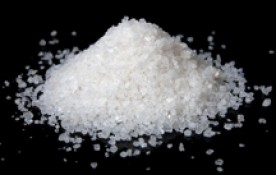 We are fortunate to have the following instructions for salt-preserving mushrooms come from Galina Plizga, a talented and experienced mushroom preserver. She has generously shared her bounty over the years at Albion, and now we can make our own. Thank you, Galina!
We are fortunate to have the following instructions for salt-preserving mushrooms come from Galina Plizga, a talented and experienced mushroom preserver. She has generously shared her bounty over the years at Albion, and now we can make our own. Thank you, Galina!
Advantages:
Doesn’t require freezer space
Mushrooms are pre-seasoned and ready to use as an appetizer or in recipes
Disadvantages:
Not suitable for more fragile, delicate fungi
May require refrigeration in warmer areas
Method:
3 – 4 pounds fresh mushrooms, cleaned and stems cut short
Kosher or pickling salt (NOT table salt)
6 – 10 juniper berries, crushed (optional)
10 black pepper berries, whole
1 big bunch of fresh dill with flowers
20 gloves of garlic smashed
Horseradish leaves or radish leaves
Raspberry leaves or blackberry leaves
Oak leaves
Sour cherry leaves
Boil the mushrooms in salted water for 5 minutes. Drain and let them cool.
Place a clean plate or other top on the mushrooms and weigh it down. I use a quart Mason jar filled with water. Let this sit in a cool, dark place for 10 days. Refrigerate if it is hot. After the first day, check to ensure that the mushrooms are submerged in their own brine. If not, boil 1 pint of water with 2 tablespoons kosher salt and let it cool. Pour over the mushrooms and continue fermenting. If there is too much salt, soak the mushrooms in water for a few minutes. Try periodically to see if they taste “done”, then stop soaking once you are satisfied. After 10 days taste and start eating.
Galina usually makes a lot, so she freezes in ziplock bags whatever she won’t use within the next 2 months.
* Please bear in mind that salt is the means of preservation here, so it isn’t a good idea to skimp here. Make notes as you proceed and you’ll soon be able to adjust ingredients to your own preferences!
One way to serve:
Salad: Boiled potatoes, onion, fresh dill and cut salted mushrooms. Combine the night before and refrigerate. Take out a couple of hours prior to serving.
Vinegar Pickled Mushrooms
Another method of preservation, also courtesy of Galina Plizga, involves pickling with vinegar in boiling water bath. The acidic environment created by the use of vinegar prevents the growth of Clostridium botulinum, the bacterium responsible for botulism. The following recipe can be varied with regard to seasoning, but one must strictly observe the quantity of vinegar.
Advantages:
May be stored in pantry if processed in a water bath. Flavor with different vinegars, herbs, etc. if desired.
Mushrooms are pre-seasoned and ready to use as an appetizer or in recipes
Disadvantages: Pronounced vinegar flavor can overpower delicate mushrooms. Choose those with bolder flavors for this method.
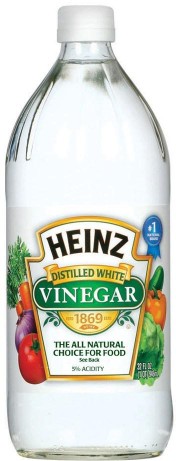
Good for: Substantial mushrooms such as Bolete buttons, Chanterelles, Russula spp.
Equipment:
Canning pot and rack
Sterilized canning jars and lids
Method:
Fresh mushrooms (Galina uses very small porcini, chanterelles) boiled in salted water for 5 minutes
Pickling Marinade, per liter:
1 liter water
¾ C vinegar
1 Tbl salt
1 tsp sugar
Peppercorns
Mustard seed
Allspice
Juniper berries
Laurel leaves
Boil water with vinegar. Add seasonings.
After the hot mushrooms have been placed in the hot sterilized jar, the pickling marinade should be poured over them while still hot, ensuring that all the mushrooms are covered and leaving ½” headspace. The lid should be screwed shut, and the mushrooms pasteurized in hot water canning bath (see the Ball Blue Book if you’re not familiar with canning) to boil for 10 minutes. To check jars for leakage, they should be turned upside down on a cloth until the next morning. If any leak, you can eat them in a day or so (keep in the refrigerator), but do not preserve for later.
Intact jars should then be placed in a cool, dark place, where they will keep for years.
Pressure Canning
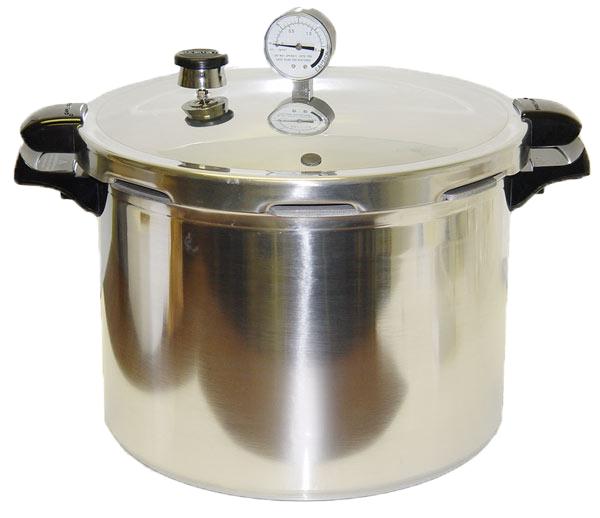
Pressure canning is done for canned mushrooms NOT utilizing vinegar to create an acid environment. Have you had experience with this method? We would love to hear about your experiences and share them here.
Advantages: May be stored in pantry. Flavor with herbs, etc. if desired
Disadvantages: Requires pressure canning, which is somewhat involved.
Good for: Substantial mushrooms such as Bolete buttons, Chanterelles, Russula spp., etc..
Equipment:
Pressure canning pot and rack
Sterilized canning jars and lids
Method: Very Important — Canning non-acid food requires careful technique and the use of a pressure canner to prevent botulism. Caused by the bacterium Clostridium botulinum, botulism produced neurotoxins and can be fatal. Instructions for pressure canning can be found in the Ball Blue Book or The Complete Pressure Cooker and Canner Cookbook by Polly Ann Lewis

